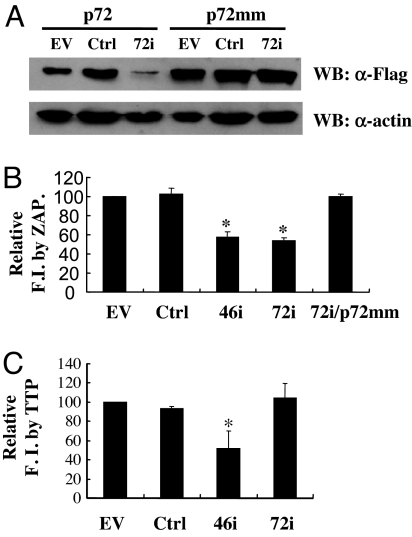Fig. 4.
Depletion of p72 by RNAi reduced ZAP's activity. (A) The plasmid expressing Flag-tagged p72 or the p72 rescue plasmid (p72 mm) was cotransfected into 293TRex cells with the plasmid expressing control shRNA (Ctrl) or the shRNA directed against p72 (72i). The expression levels of the p72 proteins were judged by Western blotting using anti-Flag and anti-β-actin antibodies. (B) The pMLV-luc reporter was cotransfected with the plasmid expressing the indicated shRNA or 72i plus p72 mm into 293TRex-ZAP cells. Immediately after transfection, tetracycline was added to induce ZAP expression. Forty-eight hours after transfection, the luciferase activities were measured. Fold inhibition was calculated as in Fig. 3. Relative fold inhibition was calculated as the fold inhibition in the absence of the shRNA (empty vector) divided by the fold inhibition in the presence of the indicated RNAi. The data are means + SE of four independent experiments. The asterisks denote P < 0.05. (C) The ARE-containing reporter, pGL3-ARE-Luc, was cotransfected with the plasmid expressing the indicated shRNA into 293TRex-TTP cells. Immediately after transfection, tetracycline was added to induce TTP expression. Forty-eight hours after transfection, the luciferase activities were measured. Fold inhibition was calculated as the luciferase activity in the mock-treated cells divided by the luciferase activity in the tetracycline-treated cells. Relative fold inhibition was calculated as the fold inhibition in the absence of the shRNA (empty vector) divided by the fold inhibition in the presence of the indicated shRNA. The data are means + SE of three independent experiments. The asterisks denote to P < 0.05. EV, empty vector; 46i, shRNA-directed against the exosome component hRrp46; FI, fold inhibition.

